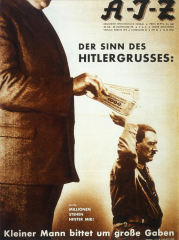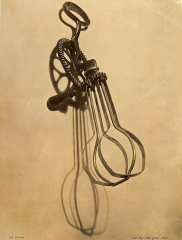![]()
![]()
![]()
Use LEFT and RIGHT arrow keys to navigate between flashcards;
Use UP and DOWN arrow keys to flip the card;
H to show hint;
A reads text to speech;
16 Cards in this Set
- Front
- Back
|
Dada art movement
|
Dada movement mostly in Europe but stretched out to America and Japan. No cohesive style or narrative to what Dada was. Described as “nomadic” and often created by people who were refugees of the First World War.
Dada was an anarchic assault on art and breaking all laws and social systems that dictated what was “proper”. A deliberate infraction on the laws of order. Embrace of chaos. A set of tactics and strategies and an intervention into politics to reach a large audience. |
|

|
Hannah HÖCH
Cut with the Kitchen Knife through the Beer Belly of the Weimar Republic c. 1919 An example of the framework of photomontage. Everything looks random, haphazard, and heterogeneous; No regard for scale. Big white gaps don’t give us a homogeneous quality and contribute to the random nature. In contrast to timeless meanings, the fact that these are taken from ephemeral places like newspapers shows the shifting of words and meanings over time due to context. They work within the conditions of mass media. |
|

|
Raoul HAUSMANN
ABCD: Portrait of the Artist 1923‐4 Includes cross-section of female reproductive system and phallic imagery. Like Hoch’s work, but not nearly as chaotic. |
|

|
John HEARTFIELD
Adolf the Superman Swallows Gold and Spouts Junk 1932 Examples of politicized photomontages. Both show a fusion of life and death. They address political troubles with domestic and national trouble. No clear message or narrative to be open to interpretation. Airbrushed to erase seams and create something more homogenous. |
|

|
John HEARTFIELD
Meaning of the Hitler Salute: Little man asks for big gifts! Motto: Millions stand behind me. Cover of Workers Illustrated Magazine (AIZ) 1932 Heartfield worked for the AIZ (Workers Pictorial Magazine). He was later persecuted once Hitler came to power and eventually interred at a labor camp. |
|
|
Andre Breton
|
Breton was considered the leader of the Parisian surrealist movement. He authored several novels, poems and manifestos about surrealism, many of which contradict each other.
Worked as a nurse during the First World War and would have key experiences while working with shell-shocked patients from the trenches. Instead of recovering in this peaceful environment, they kept reliving traumatic experiences on the battlefield repeatedly (repetition compulsion as Freud called it) and get worse. This is where he became interested in the unconscious and esp. in Freud. In his novel Nadja, he emphasizes the artistic nature of both literature and photography. |
|

|
Jacques‐André BOIFFARD
Untitled photo from Breton’s novel Nadja 1928 Idea of the found object important to surrealism to open up the unconscious to speak to you in a way they don’t usually do. Breton drawn to a phrase, “Cinderella ashtray” and a “slipper spoon” he found at a flea market. It spoke to his unconscious. |
|
|
Surrealism
|
Created as a response to the machine aesthetic shown in the German and Russian machine technology. They instead embrace the body, desire and continuity, chance. Repressed desire is allowed to flow.
Rosalind Krauss makes the case that all photographs are representations and not just pure indexical images. Photographs are infused with spacing, which betray their status as representations. Reality itself is constructed. No pure “reality” because the way we perceive reality is very much shaped and framed by our own unconscious desires. Because reality is a construction, so are photographs. Surrealisst photographers didn't typically use photomontage, but made use of the spacing noted in photomontage with techniques such as solarization, the incorporation of cast shadows, combination printing, and double exposure. |
|

|
Man RAY
Man 1917 Man Ray developed his own variant of the Photogram and within his photo used cast shadows to create an impossible duality |
|

|
Man RAY
Untitled 1924 A doubling of woman's breast served as deliberate repetition and becomes a sign of intention to communicate a specific meaning. Surrealist photographers were going against he grain and troubling what the viewer expected. |
|

|
Maurice TABARD
Untitled 1929 Combination print This reality cannot exist and can't easily be trusted. |
|

|
Man RAY
Portrait of Marquise Casati 1922 Double exposure |
|

|
Andre KERTESZ
Distortion 126 1933 Mirrored doubling |
|

|
BRASSAI
Group in a Dance Hall 1932 Creates a disjointed reality and is indexed by the photograph. |
|

|
Raoul UBAC
Battle of the Amazons 1939 Solarized print Photograph of naked bodies superimposed on one another. The photo was exposed twice (a technique popularized by Man Ray) to show a scene that can’t happen in reality. |
|

|
Hans Bellmer
Doll 1935 Made up of doll leg sculptures photographed and painted over with oil paint to create a grotesque image with twinning/copying/duality motif. |

